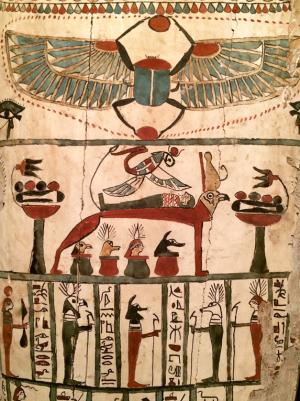The funerary scene shown here is remarkably weird. The deceased is shown on a funerary bed which has …
 An ancient Egyptian coffin with strange and
amateurish decorations has been revealed, shedding light on a tumultuous
period in Egyptian history when the Persian Empire was in control of
the region.
An ancient Egyptian coffin with strange and
amateurish decorations has been revealed, shedding light on a tumultuous
period in Egyptian history when the Persian Empire was in control of
the region.In 525 B.C., Persian King Cambyses marched into Memphis, the Egyptian capital, inaugurating a period of Persian rule that would last for more than a century. The Persian Empire was a vast entity that stretched from modern-day Afghanistan to the west coast of Turkey. Ancient texts say that the Persian kings deported Egyptian artists and used them for building projects in Persia.
The coffin bears a series of unusual features that are likely related to the Persian Empire's deportation of artists.
"Many of the best artists in Egypt were taken by the Persians back to Persepolis and Susa as POWs and war booty — you can see their work in those places. There seems to have been a dearth of masters for some time, so that fewer and fewer artists got proper training," Gayle Gibson, an Egyptologist and educator at Toronto's Royal Ontario Museum, told Live Science in an email.
Gibson presented the coffin at the Society for the Study of Egyptian Antiquities Scholars' Colloquium, which was held Nov. 13 to 16 in Toronto.
Odd features
There are several odd features on the coffin that reflect the lack of knowledge the ancient artist had, Gibson said.
For instance, the deceased is depicted lying on a funerary bed, and the bed has a human-headed bird called a Ba. Flying over the deceased is a winged snake wearing a crown associated with the goddess Hathor. Below them are four jars bearing the heads of the four Sons of Horus, but the jars have a "goofy" appearance, Gibson said.
To an Egyptologist, this is a bizarre scene, Gibson said. "This is the only funerary bed I know of with a Ba's head," she told the Toronto audience, also noting that "we have a winged snake with Hathor's crown — very odd."
There are other oddities. The collar wrapped around the top of the coffin contains two creatures that look almost fishlike. The artist was likely trying to draw falcons, a symbol of the god Horus, but drew them very poorly, Gibson said.
A Mehen snake, a protective deity in Egypt, is also poorly drawn and actually stops at one point and starts in another, something strange for a protective deity. "The artist doesn't really understand the purpose of the Mehen snake," Gibson said.
Mike Sigler, a collector and Egyptian antiquities enthusiast who lives in Kentucky and now owns the coffin, sent a picture to Live Science showing that the ancient artist clumsily attempted to correct an error in an alternating pattern by scratching out an image of a scepter.
Ancient brain drain
Although there is no longer a mummy in the coffin, its inscriptions say that it belonged to someone named Denit-ast, or Dent-ast, likely a woman. Radiocarbon dating of her coffin indicates that she lived at a time when her country was under Persian control.
Ancient texts tell tales of the deportation of Egyptian artists to Persia during this time. Diodorus Siculus, who died around 30 B.C., said that Cambyses, the conqueror of Egypt, transferred both precious metals and artists from Egypt to Persia.
Additionally, Persian King Darius I bragged about the Egyptian artists he acquired in a text describing the construction of his palace at Susa. "The goldsmiths who wrought the gold, those were Mede and Egyptians. The men who wrought the wood, those were Sardians and Egyptians … the men who adorned the wall, those were Medes and Egyptians" Darius said (translation by Roland Kent).
Authentication
Gibson told the Toronto audience that when she first showed the coffin to other Egyptologists, some expressed skepticism and wondered if it was a fake created before Sigler owned it.
However, radiocarbon dating places the coffin in the Persian period and analysis of its wood indicates that it's sycamore, a wood that was commonly used in ancient Egypt. Additionally, an analysis of the coffin's blue pigments found that the pigment was Egyptian blue, which indicates that the coffin is authentic, Gibson said.
Sigler purchased the coffin in August 2013 from the Edgar L. Owen gallery, which sold it on behalf of a private collector. Paperwork that Sigler received indicates that the collector acquired it from the European art market in 1980. Its history before that is unknown.
Gibson is well-known for her Egyptological work. In the 1990s she
helped identify a mummy in Niagara Falls, Canada, as likely being that
of pharaoh Ramesses I. The mummy was later returned to Egypt with full
military honors.
Given Gibson's reputation, Sigler sought her out and asked her for help in understanding the coffin's strange features.
Despite its odd features, Gibson believes the coffin is not a fake. "I
think there is really no doubt that this one is genuine," she said.
Sigler told Live Science that he hopes to find other examples of the
coffin's unusual imagery. He said that he is interested in donating the
coffin to a museum in the future.
The pigment and wood analysis was carried out by Microscopist William
Randle while radiocarbon dating was conducted at the University of
Georgia’s Center for Applied Isotope Studies.

No comments:
Post a Comment